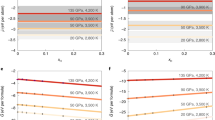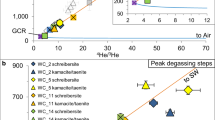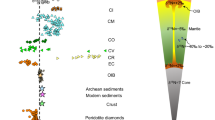Abstract
The initial isotopic composition of water in the Solar System is of paramount importance to understanding the origin of water on planetary bodies but remains unknown, despite numerous studies1,2,3,4,5. Here we use the isotopic composition of hydrogen in calcium–aluminium-rich inclusions (CAIs) from primitive meteorites, the oldest Solar System rocks, to establish the hydrogen isotopic composition of water at the onset of Solar System formation. We report the hydrogen isotopic composition of nominally anhydrous minerals from CAI fragments trapped in a once-melted host CAI. Primary minerals have extremely low D/H ratios, with δD values down to −850‰, recording the trapping of nebular hydrogen. Minerals rich in oxidised iron formed before the capture of the fragments record the existence of a nebular gas reservoir with an oxygen fugacity substantially above the solar value and a D/H ratio within 20% of that of the Earth’s oceans. Hydrogen isotopes also correlate with oxygen and nitrogen isotopes, indicating that planetary reservoirs of volatile elements formed within the first 2 × 105 years of the Solar System, during the main CAI formation epoch. We propose that the isotopic composition of inner Solar System water was established during the collapse of the protosolar cloud core owing to a massive admixture of interstellar water.
This is a preview of subscription content, access via your institution
Access options
Access Nature and 54 other Nature Portfolio journals
Get Nature+, our best-value online-access subscription
$29.99 / 30 days
cancel any time
Subscribe to this journal
Receive 12 digital issues and online access to articles
$119.00 per year
only $9.92 per issue
Buy this article
- Purchase on Springer Link
- Instant access to full article PDF
Prices may be subject to local taxes which are calculated during checkout




Similar content being viewed by others
Data availability
All data used in the manuscript are presented in the Supplementary Data and are available on request from the corresponding author.
References
Robert, F. The origin of water on Earth. Science 293, 1056–1058 (2001).
Drouart, A., Dubrulle, B., Gautier, D. & Robert, F. Structure and transport in the solar nebula from constraints on deuterium enrichment and giant planets formation. Icarus 140, 129–155 (1999).
Jacquet, E. & Robert, F. Water transport in protoplanetary disks and the hydrogen isotopic composition of chondrites. Icarus 223, 722–732 (2013).
Cleeves, L. I. et al. The ancient heritage of water ice in the solar system. Science 345, 1590–1593 (2014).
Yang, L., Ciesla, F. J. & Alexander, C. M. O. ’D. The D/H ratio of water in the solar nebula during its formation and evolution. Icarus 226, 256–267 (2013).
Pignatale, F. C., Charnoz, S., Chaussidon, M. & Jacquet, E. Making the planetary material diversity during the early assembling of the solar system. Astrophys. J. Lett. 867, 7pp (2018). L23.
Connelly, J. N. et al. The absolute chronology and thermal processing of solids in the solar protoplanetary disk. Science 338, 651–655 (2012).
MacPherson, G. J. in Meteorites and Cosmochemical Processes Treatise on Geochemistry Vol. 1, 2nd edn (ed. Davis, A. M.) 139–179 (Elsevier, 2014).
Bonal, L., Quirico, E., Bourot-Denise, M. & Montagnac, G. Determination of the petrologic type of CV3 chondrites by Raman spectroscopy of included organic matter. Geochim. Cosmochim. Acta 70, 1849–1863 (2006).
El Goresy, A. et al. Efremovka 101.1: a CAI with ultrarefractory REE patterns and enormous enrichments of Sc, Zr and Y in fassaite and perovskite. Geochim. Cosmochim. Acta 66, 1459–1491 (2002).
Aléon, J., Marin-Carbonne, J., McKeegan, K. D. & El Goresy, A. O, Mg, and Si isotope distributions in the complex ultra-refractory CAI Efremovka 101.1: assimilation of ultra-refractory, FUN, and regular CAI precursors. Geochim. Cosmochim. Acta 232, 48–81 (2018).
Lévy, D., Aléon, J., Aléon-Toppani, A. & Brunetto, R. Alteration phases in the E101.1 compound CAI: evidence of nebular processes? Meteorit. Planet. Sci. 54, A242 (2019). S2.
Lévy, D. et al. NanoSIMS imaging of D/H ratios on FIB sections. Anal. Chem. 91, 13763–13771 (2019).
Stephant, A., Remusat, L. & Robert, F. Water in type I chondrules of Paris CM chondrite. Geochim. Cosmochim. Acta 199, 75–90 (2017).
Piani, L. et al. Earth’s water may have been inherited from material similar to enstatite chondrite meteorites. Science 369, 1110–1113 (2020).
Yang, X., Keppler, H. & Li, Y. Molecular hydrogen in mantle minerals. Geochem. Persp. Lett. 2, 160–168 (2016).
Roskosz, M. et al. Kinetic D/H fractionation during hydration and dehydration of silicate glasses, melts and nominally anhydrous minerals. Geochim. Cosmochim. Acta 233, 14–32 (2018).
Yurimoto, H., Ito, M. & Nagasawa, H. Oxygen isotope exchange between refractory inclusion in Allende and solar nebula gas. Science 282, 1874–1877 (1998).
Aléon, J. Oxygen isotopes in the early protoplanetary disk inferred from pyroxene in a classical type B CAI. Earth Planet. Sci. Lett. 440, 62–70 (2016).
Meibom, A. et al. Nitrogen and carbon isotopic composition of the Sun inferred from a high-temperature solar nebula condensate. Astrophys. J. 656, L33–L36 (2007).
Füri, E., Chaussidon, M. & Marty, B. Evidence for an early nitrogen isotopic evolution in the solar nebula from volatile analyses of a CAI from the CV3 chondrite NWA 8616. Geochim. Cosmochim. Acta 153, 183–201 (2015).
Brennecka, G. A. et al. Astronomical context of solar system formation from molybdenum isotopes in meteorite inclusions. Science 370, 837–840 (2020).
Grewal, D. S., Dasgupta, R. & Marty, B. A very early origin of isotopically distinct nitrogen in inner solar system protoplanets. Nat. Astron. https://doi.org/10.1038/s41550-020-01283-y (2021).
Lee, Y.-N., Charnoz, S. & Hennebelle, P. Protoplanetary disk formation from the collapse of a prestellar core. Astron. Astrophys. 648, A101 (2021).
Robert, F. et al. Hydrogen isotope fractionation in methane plasma. Proc. Natl Acad. Sci. USA 114, 870–874 (2017).
Thiemens, M. H. History and applications of mass-independent isotope effects. Annu. Rev. Earth Planet. Sci. 34, 217–262 (2006).
Telus, M., Huss, G. R., Ogliore, R. C., Nagashima, K. & Tachibana, S. Recalculation of data for short-lived radionuclide systems using less-biased ratio estimation. Meteorit. Planet. Sci. 47, 2013–2030 (2012).
Deloule, E., France-Lanord, C. & Albarède, F. in Stable Isotope Geochemistry: A Tribute to Samuel Epstein Special Publications Vol. 3 (eds Taylor, H. P. et al.) 53–62 (Geochemical Society, 1991).
Bureau, H., Raepsaet, C., Khodja, H., Carraro, A. & Aubaud, C. Determination of hydrogen content in geological samples using elastic recoil detection analysis (ERDA). Geochim. Cosmochim. Acta 73, 3311–3322 (2009).
Xia, Q.-K., Dallai, L. & Deloule, E. Oxygen and hydrogen isotope heterogeneity of clinopyroxene megacryst from Nushan volcano, SE China. Chem. Geol. 209, 137–151 (2004).
Aléon, J., Engrand, C., Robert, F. & Chaussidon, M. Clues to the origin of interplanetary dust particles from the isotopic study of their hydrogen-bearing phases. Geochim. Cosmochim. Acta 65, 4399–4412 (2001).
Acknowledgements
Discussions with L. Remusat and F. Robert and help from the NanoSIMS staff R. Duhamel and A. Gonzalez-Cano are appreciated. The FIB section preparation was partly supported by the French Renatech network. D. Troadec is warmly thanked. This work was supported by ATM grants from the Museum National d’Histoire Naturelle and by the French National Program of Planetology PNP INSU/CNRS.
Author information
Authors and Affiliations
Contributions
J.A. and A.A.-T. designed and supervised the study. D.L. characterized the sample, performed the NanoSIMS analyses and reduced the data. H.B. and H.K. characterized the standards by ERDA. F.B. performed scanning electron microscope imaging of the FIB sections. J.A., A.A.-T. and D.L. interpreted the data. J.A. and A.A.-T. wrote the manuscript with input from all other co-authors.
Corresponding author
Ethics declarations
Competing interests
The authors declare no competing interests.
Peer review
Peer review information
Nature Astronomy thanks Romain Tartese and the other, anonymous, reviewer(s) for their contribution to the peer review of this work.
Additional information
Publisher’s note Springer Nature remains neutral with regard to jurisdictional claims in published maps and institutional affiliations.
Supplementary information
Supplementary Information
Supplementary Discussion, Figs. 1–10 and references.
Supplementary Data
Supplementary Tables 1–3.
Rights and permissions
About this article
Cite this article
Aléon, J., Lévy, D., Aléon-Toppani, A. et al. Determination of the initial hydrogen isotopic composition of the solar system. Nat Astron 6, 458–463 (2022). https://doi.org/10.1038/s41550-021-01595-7
Received:
Accepted:
Published:
Issue Date:
DOI: https://doi.org/10.1038/s41550-021-01595-7
This article is cited by
-
An open source Python library for environmental isotopic modelling
Scientific Reports (2023)
-
The Habitability of Venus
Space Science Reviews (2023)



